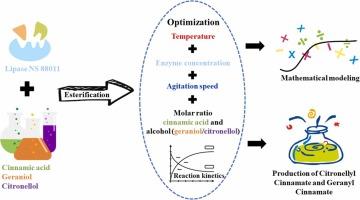冬凌草精油与肉桂酸之间酶法酯化过程的数学建模
IF 6.2
1区 农林科学
Q1 AGRICULTURAL ENGINEERING
引用次数: 0
摘要
要探索通过酶催化的酯化过程,数学模型是一种不可或缺的创新工具。本研究旨在研究单萜醇的酯化过程,特别是香叶醇和香茅醇,它们是香茅精油(Cymbopogon winterianus)的主要成分。重点在于了解它们在有机溶剂体系中与肉桂酸反应的复杂动态,并采用固定化的商用脂肪酶 NS 88011 作为生物催化剂。本研究调查的自变量如下:温度(50、60 和 70 °C)、酶浓度(1、5、10 和 15 %)、搅拌速度(50、125 和 200 rpm)以及肉桂酸与醇(香叶醇/香茅醇)的摩尔比(1:2、1:3、1:6、1:9 和 1:12)。优化条件为催化剂浓度为 10%、温度为 60 °C、搅拌速度为 50 rpm、摩尔比为 1:3(酸:醇)。在这些条件下,120 小时的反应时间内,肉桂酸香茅酯的产量为 7845 mg/L(52.3%),肉桂酸香叶酯的产量为 15089 mg/L(48.3%)。准确描述反应动力学的最佳拟合模型被确定为 Ping Pong bi bi 模型。这项研究强调了系统参数优化和动力学模型选择对于提高酶法酯化过程效率的重要性,从而为酶催化领域的进步做出了重大贡献。本文章由计算机程序翻译,如有差异,请以英文原文为准。

Mathematical modeling of enzymatic esterification process between essential oil from Cymbopogon winterianus and cinnamic acid
To explore esterification processes via enzymatic catalysis, mathematical models represent an innovative and indispensable tool. This study aims to investigate the esterification process of monoterpene alcohols, specifically geraniol and citronellol, which are key components of citronella essential oil (Cymbopogon winterianus). The focus lies in understanding the complex dynamics of their reaction with cinnamic acid within an organic solvent system, employing the immobilized commercial lipase NS 88011 as the biocatalyst. The independent variables investigated in this study were as follows: temperature (50, 60, and 70 °C), enzyme concentration (1, 5, 10, and 15 %), agitation speed (50, 125, and 200 rpm), and the molar ratio of cinnamic acid to alcohol (geraniol/citronellol) (1:2, 1:3, 1:6, 1:9, and 1:12). The optimized conditions were found to be 10 % catalyst concentration, 60 °C, 50 rpm agitation speed, and a molar ratio of 1:3 (acid:alcohol). Under these conditions, the production yielded 7845 mg/L (52.3 %) of citronellyl cinnamate and 15089 mg/L (48.3 %) of geranyl cinnamate within 120 h of the reaction time. The best-fitting model that accurately described the reaction kinetics was determined to be the Ping Pong bi bi model. This research underscores the critical importance of systematic parameter optimization and the selection of kinetic models to enhance the efficiency of enzymatic esterification processes, thereby making a substantial contribution to the progress of the field of enzymatic catalysis.
求助全文
通过发布文献求助,成功后即可免费获取论文全文。
去求助
来源期刊

Industrial Crops and Products
农林科学-农业工程
CiteScore
9.50
自引率
8.50%
发文量
1518
审稿时长
43 days
期刊介绍:
Industrial Crops and Products is an International Journal publishing academic and industrial research on industrial (defined as non-food/non-feed) crops and products. Papers concern both crop-oriented and bio-based materials from crops-oriented research, and should be of interest to an international audience, hypothesis driven, and where comparisons are made statistics performed.
 求助内容:
求助内容: 应助结果提醒方式:
应助结果提醒方式:


